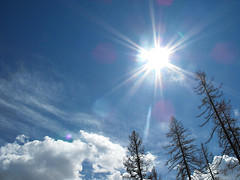Nothing can quite put a damper on summer fun than a bad case of sunburn. If you've ever been afflicted by the telltale red skin and prickly heat of sunburn, it's likely you committed one of these four common sunscreen application mistakes:
1) You applied sunscreen immediately before sun exposure.
Sunscreen needs time to absorb into the skin. For maximum benefits, try to wait at least 15 minutes after application before venturing outside.
2) You applied too little sunscreen.
There's no such thing as too much sunscreen. Start with a golf ball sized amount, and apply the lotion systematically, massaging it into your arms, legs, face, back on the neck and ears—wherever your skin will be exposed to the sun.
3) You forgot to reapply.
Sunscreen is effective for a maximum of two hours, or about 40 to 80 minutes if you're sweating or swimming. Also remember that the sun can penetrate fog and cloud cover, so wear sunscreen even when the sun's not shining.
4) You used a lotion with a too-low SPF (Sun Protection Factor).
Choose a water-resistant sunscreen that's at least 30 SPF. Also ensure that your sunscreen provides protection from both UVA and UVB rays. Be advised, however, that sunscreens with a SPF higher than 30 won't necessarily buy you more time in the sun. A 30 SPF sunscreen will protect you from 96% of sunburn-causing rays, while SPF 50 provides only slightly more protection: 98%.
Sunscreen: Tips to Wear It Well [MD Anderson Cancer Center]
8 Sunscreen Mistakes You're Probably Making [Huffpost]
How to apply sunscreen (and how not to) [Well + Good]

![I [GFDL, CC-BY-SA-3.0 or GFDL], from Wikimedia Commons](http://respage.com/cms/img/627.jpg)


 Equal Housing Opportunity
Equal Housing Opportunity